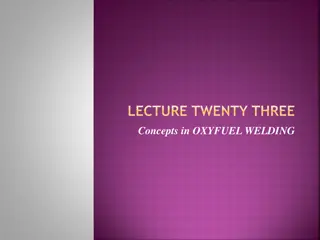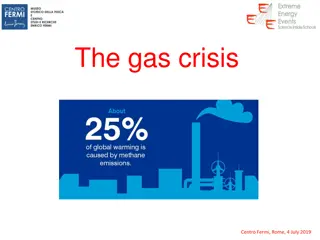Understanding the Kinetic Theory of Gases and Ideal Gas Model
Explore the Kinetic Theory of Gases, the Molecular Model of Ideal Gases, and concepts like pressure, temperature, and heat capacity. Understand the fundamental properties of gases, including the distribution of molecular speeds and equations that describe gas behavior. Learn about the mole concept, molar mass, and equations of state, while delving into the characteristics of ideal gases and corrections for non-ideal behavior. Discover key principles through examples and explanations.
Download Presentation

Please find below an Image/Link to download the presentation.
The content on the website is provided AS IS for your information and personal use only. It may not be sold, licensed, or shared on other websites without obtaining consent from the author. Download presentation by click this link. If you encounter any issues during the download, it is possible that the publisher has removed the file from their server.
E N D
Presentation Transcript
Chapter 2: The Kinetic Theory of Gases Molecular Model of an ideal gas Pressure, temperature, and RMS speed Heat Capacity and Equipartition of Energy Distribution of Molecular Speeds
Confusing Notations (don't be confused): N: number of molecules n: number of moles NA: Avogadro's number: 6.02 1023. M: molar mass (how much mass per mole) m: mass of ONE molecule mtotal: total mass p: pressure P: momentum
What is mole; and what is molar mass? I have 2.5 dozens of identical coins with total weight of 300 g. How much weight does one dozen of coins have? How much weight does one coin have? I have 2.5 moles of identical molecules with total weight of 300 g. How much weight does one mole of molecules have? How much weight does one molecule have? # of dozens $total= n$dozen $dozen= 12$1 A dozen refers to 12 objects. A mole refers to 6.02 x 1023 objects (we use NAto represent 6.02 x 1023) # of moles mtotal= nM M= NAm Molar mass Single molecule mass
Equation of State From experiments: V is proportional to n V is proportional to 1/p p is proportional to T ?? = ??? ? = 8.314472 ?/??? ? ? = 0.08206? ??? ??? ? ?? =?????? ?? ?? = ??? ?
Unit of Pressure Standard atmosphere (atm) 9.8692 10 6 Pounds per square inch (psi) 1.450377 10 4 Pascal Bar Torr (Pa) (bar) (Torr) 7.5006 10 3 1 Pa 1 N/m2 10 5 100 kPa 106dyn/cm2 1 bar 105 0.98692 750.06 14.50377 1.01325 105 1 atm 1.01325 1 760 14.69595 1 Torr 1 mmHg 1/760 1.315789 10 3 1.333224 10 3 1.933678 10 2 1 Torr 133.3224 6.8948 103 6.8948 10 2 6.8046 10 2 1 psi 51.71493 1 lbf /in2
Example 2.1 Suppose your bicycle tire is fully inflated, with an absolute pressure of 7.00 105 Pa at a temperature of 18.0 C. What is the pressure after its temperature has risen to 35.0 C on a hot day? Assume there are no appreciable leaks or changes in volume.
How to describe the status of a gas? And what is ideal gas ? Ideal gas: (1) no inter-molecular interactions (each gas molecule does not feel the others); (2) no volume (each gas molecule is considered as a point mass particle) Corrections for non-ideal gas (van der Waals Equation): (p+an2 V2)(V nb)= nRT
p-V diagram Ideal Gas Non-Ideal Gas
What is the origin of the pressure? p=F What is pressure ? A Where does Force come from? Air molecules hitting/bouncing the wall Let's look at one molecule: Fx= Px t
What is the origin of the pressure? How many molecules hitting the wall within a certain time period? Molecules with vx within a volume could hit the wall ? ??= ? ?? ? Numbers of molecules that hit the wall: ? ??=1 2 ? ?? ??=1 ? ?? ?? ? 2 Momentum change of one molecule that hit the wall ??= 2? ?? Sum of momentum changes of all molecules that hit the wall 1 2 ? ?? ?? ? = ? ??2? ??,?????= ? ?? ??= 2? ?? ?? ?
What is the origin of the pressure? Total force due to the molecule collisions ? = ??,????? = ? ??2? ?? ? Pressure on the wall ? =? ?= ? ??2? ? Average vx vs v v2= vx 2+ vy 2+ vz 2 (v2)av=(vx 2)av+(vy 2)av=1 2)av+(vz 2)av= 3(vx 2)av 3(v2)av (vx
What is the origin of the pressure? Pressure on the wall ? = ? ??2? ?= ?1 ?=2 3?2? ? ?=2 ? ? =2 1 2? ?2? ??? ? 3?? 3 3 Total kinetic energy of ALL molecules Average kinetic energy of ONE molecule pV=2 3EkN=2 n=N 3Ktr= nRT NA Ek=3 Ktr=3 k=R 2kT 2nRT NA
Kinetic energy of molecules vs Temperature Ek=3 2kT=1 Ktr=3 2m(v2)av 2nRT= N Ek Total kinetic energy of all molecules Average kinetic energy of one molecule Root-mean-square speed (rms speed) 2=(v2)av vrms ?2 ????= ?? 3 2kT=1 3?? ? 3?? ? 2 2mvrms ????= =
Summary Average kinetic energy of single molecule on depends on temperature Ek=3 2kT Root-mean-square speed depends on both temperature and molecular mass 3?? ? 3?? ? ????= =
Example 2.4 (a)What is the average kinetic energy of a gas molecule at 20.0 C? (b)Find the rms speed of a nitrogen molecule (N2) at this temperature.
How do we know the specific heat for ideal gas? Recall from Ch 1: Molar heat capacity C=1 dQ dT Q= nC T n There are two types of Molar heat capacity CV=1 n(dQ dT) constant volume Cp=1 n(dQ dT) constant pressure
How do we know the specific heat for ideal gas? For ideal gas, if you add heat into the system, where does the heat go? Q= Ktr Ktr=3 Q= nCV T Q= nCV T=3 2nRT 2nR T CV=3 2R
Equipartition of Energy principle Where does this 3 come from? CV=3 2)av=1 3(v2)av 2R (vx Ek=1 2m(v2)av=1 2)av+(vy 2)av+(vz 2)av)= Ek,x+Ek, y+Ek,z 2m((vx One degree of freedom gives one equipartition of energy CV=dof R 2
What is degree of freedom? Monatomic vs Diatomic molecules CV=dof R dof = 5 z 2 z y y x x z dof = 3 CV=3 y CV=5 2R x 2R
Degree of freedom vs ?? Translation: dof: 3 Rotation: dof: 2 Vibration: dof: 2
What is degree of freedom? Kinetic energy x, y, and z dof = 6 CV=6 Potential energy (vibration) x, y, and z 2R In general, the following could contribute to dof. Kinetic energy Rotational energy Vibration energy
Do all the air molecules move with the same speed? vmp vavvrms 3/2 ? ?2? ??2/2?? ? ? = 4? 2??? 3?? ? 2?? ? 8?? ?? ????= ???= ???=
Speeds 3/2 ? ?2? ??2/2?? ? ? = 4? 2??? df (v) dv = 0 Solve for vmp ???= ?? ? ?? 0 ?2? ? ?? ????= 0























